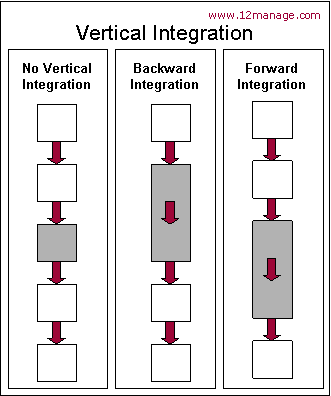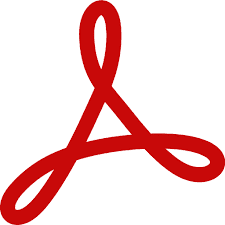What is Vertical Integration?
Vertical Integration is an approach for increasing or decreasing the level
of control which a firm has over its inputs and distribution of outputs.

Vertical integration is the extent to which an organization controls its
inputs and the distribution of its products and services. There are two sorts
of vertical integration: backward integration and forward integration. A firm’s
control of its inputs or supplies is known as: backward integration.
A firm’s control of its distribution is known as: forward integration.
Vertical integration is best understood by applying
Michael Porter’s Value Chain model.
Vertical integration refers to the degree of integration between a firm’s
value chain and the value chains of its suppliers and distributors.
Full vertical integration occurs when a firm incorporates the value-chain
of a supplier and/or that of a distribution channel into its own value chain.
This generally happens either by a firm’s acquiring a supplier and/or a distributor
or by a firm’s expanding its operations. Expanding operations means to perform
activities traditionally undertaken by suppliers or distributors. A lower
degree of vertical integration is commonly known as: Supply Chain Optimization
or also as: Supply Chain Planning. This occurs when logistical information
is exchanged between a firm and its suppliers and customers. See:
Vendor Managed Inventory.
An illustration of vertical integration may be found in the airline
industry. By performing the traditional role of travel agents, Airlines
have achieved forward integration. Likewise, by performing the role of suppliers
such as aircraft maintenance and in-flight catering, airlines have backwards
integrated. Similarly, oil refining companies have traditionally owned
their oil distribution channels such as gas stations. Sometimes they moved
into oil exploration and exploitation..
Origin of Vertical Integration. History
The strategic reasons for opting for a vertical integration strategy
have changed over the years. During the 19th century, firms used vertical
integration to achieve economies of scale. During the middle of the 20th century,
vertical integration was used to assure a steady supply of vital inputs. In
some cases, the theory of transaction cost economics was applied to backward
integration or forward integration, as a means to total cost reduction. That
is, it was cheaper for a firm to perform the role of suppliers and distributors
than to spend time and money to interact with such parties.
Subsequently, in the late 20th century, competition intensified in most industries.
Corporate restructuring resulted in vertical disintegration by reducing the
levels of vertical integration in large corporations.
Vertical disintegration is facilitated by the widespread use of information
and telecommunications technologies, which support lower transaction costs
between market participants. As lower transaction costs can be achieved using
information and communication technologies, rather than by vertically integrating,
firms start to vertically disintegrate. This effect is commonly known as “Coase’s
Law” (in recognition of Ronald Coase's Nobel price) or the “Law of
Diminishing Firms”. This law states that when the transaction costs are
decreasing, the size of the firm will also decrease.
Usage of Vertical Integration. Applications
Decisions on vertical integration are usually made in the following contexts:
- In the strategy development process, vertical integration may
be considered as a strategic choice. For example if suppliers are very powerful,
a solution to that threat is to buy a number of them up.
- When you are analyzing industry dynamics, using Porter’s Five
Forces model, vertical integration is an action to decrease the bargaining
power of suppliers and customers. Compare:
Kraljic Model.
- Vertical integration may be a path for reducing transaction costs.
Steps in Vertical Integration. Process
When you are deciding whether to vertically integrate, and to what extent,
you should consider the following issues:
- Are there economies of scope, which would make it cheaper for
a firm to control inputs and outputs?
- Are there any market external factors, which would make it more
efficient for a firm to control inputs and outputs?
- Is there a need to pursue monopoly power?
Strengths of Vertical Integration. Benefits
- Economies of scale.
- Economies of scope.
- Cost reduction.
- Competitiveness.
- Reduce threat from powerful suppliers and/or customers.
- Higher degree of control over the entire value chain.
Limitations of Vertical Integration. Disadvantages
- There is no such thing as a completely integrated or a completely non-integrated
firm. Thus the issue is not a choice between these two polar alternatives.
Rather, it is a matter of selecting the optimal degree of vertical integration.
- The degree of vertical integration can hardly be determined via quantitative
means.
- Whilst Vertical Integration may solve one headache, the firm may well
be acquiring a bunch of others. Compare
Core Competence.
- Load and capacity balancing between the old and the new activities may
be hard to achieve.
Assumptions of Vertical Integration. Conditions
- A firm has to have the competences to undertake an expanded role in
the supply chain.
Book: Kathryn Rudie
Harrigan - Vertical Integration, Outsourcing, and Corporate Strategy
Book: Roger Blair
and David Kaserman - Law and Economics of Vertical Integration and Control
|
Courses about Vertical Integration.

Beginners Course
|

Advanced Course
|

Course for Experts
|
|
|
|
The best, top-rated topics about Vertical Integration. Here you will find the most valuable ideas and practical suggestions.
|
🥇
|
Integration Strategy
Here's my summary of integration strategies:1. VERTICAL INTEGRATION:1A. Forward (Vertical) integration:= Seeking ownership or increased control over distributors or retailers.Forward integrati...
 31  15 comments
|
|
|
|
Advanced insights about Vertical Integration. Here you will find professional advices by experts.

Consultancy Tips
|

Teaching Tips
|

Practical Implementation Tips
|
|
|

|
Two More Forms of Strategic Integration Strategy, Corporate Integration
In academic literature there is a mention of at least two more types of developing strategy considered a midddle way bet...
|

|
Virtual Integration Dell’s Direct Model Case
Virtual Integration provides economic benefits of two very different business models: it offers the advantages of a tigh...
|

|
Vertically Integrated Enterprise Identifying Potential Synergy Areas
There are various approached to optimizing structures and processes in a vertically integrated enterprise. This one foll...
|
|
|
|
Various sources of information regarding Vertical Integration. Here you will find powerpoints, videos, news, etc. to use in your own lectures and workshops.

|
Vertical Integration and Horizontal Integration Difference Between Vertical Integration and Horizontal Integration
Simple explanation of the essence of the 2 main models for corporate expansion (vertical and horizontal integration) by ...
|

|
The Make or Buy Decision Vertical Integration
Should a firm make its own inputs, buy them on the spot market, or maintain an ongoing relationship with a particular su...
|

|
Integrating Forward: Meeting Demand and Managing Customers Internet Economy, CRM, Digital Economy, Demand Management, Forward Integration
This presentation provides insight into how to meet customer demand and manage customer relationship in the internet era...
|

|
Trans. Costs & Techn. Adoption VMI, Insurance Industry
Advances in frontier technology are only the first in a series of steps that lead to economic growth. The next step invo...
|

|
Strategic Transfer Pricing, Absorption Costing and Vertical Integration Transfer Pricing, Absorption Costing, Vertical Integration
This paper by Robert F. Göx analyzes the use of transfer pricing as a strategic device in divisionalized firms facing du...
|
|
|
|
Useful tools regarding Vertical Integration.

News
|

Videos
|

Presentations
|
| |

Books
|

Academic
|

More
|
|
|
|
Compare with Vertical Integration:
Horizontal Integration
| Value Chain |
Porter Five Forces |
Core Competence |
Outsourcing |
Insourcing |
Co-opetition |
Vendor Managed Inventory
| Supply Chain Planning
Return to Management Hub: Finance & Investing | Strategy & Innovation
| Supply Chain & Quality
More Management Methods, Models and Theory
|
|
|














